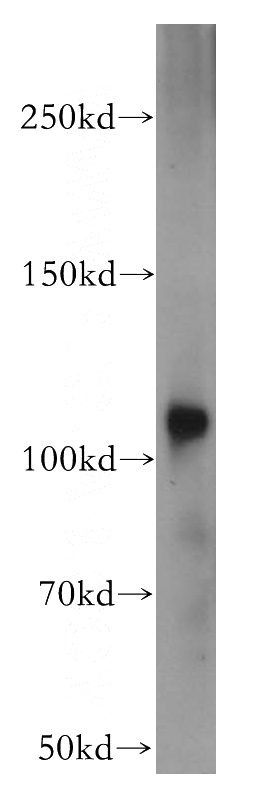-
Product Name
CD133 antibody
- Documents
-
Description
CD133 Rabbit Polyclonal antibody. Positive WB detected in mouse kidney tissue, mouse pancreas tissue. Observed molecular weight by Western-blot: 115kd-120kd
-
Tested applications
ELISA, WB
-
Species reactivity
Human,Mouse,Rat; other species not tested.
-
Alternative names
AC133 antibody; Antigen AC133 antibody; CD133 antibody; CORD12 antibody; MCDR2 antibody; MSTP061 antibody; PROM1 antibody; PROM1 1 antibody; PROM1 1 antibody; PROM1 1 antibody; PROM1 1 antibody; PROM1 2 antibody; PROM1 2 antibody; prominin 1 antibody; Prominin like protein 1 antibody; PROML1 antibody; RP41 antibody; STGD4 antibody
- Immunogen
-
Isotype
Rabbit IgG
-
Preparation
This antibody was obtained by immunization of CD133 recombinant protein (Accession Number: NM_001145847). Purification method: Antigen affinity purified.
-
Clonality
Polyclonal
-
Formulation
PBS with 0.02% sodium azide and 50% glycerol pH 7.3.
-
Storage instructions
Store at -20℃. DO NOT ALIQUOT
-
Applications
Recommended Dilution:
WB: 1:200-1:2000
-
Validations

mouse kidney tissue were subjected to SDS PAGE followed by western blot with Catalog No:109047(PROM1 antibody) at dilution of 1:500
-
Background
CD133, also known as PROM1 (prominin-1) or AC133, belongs to the prominin family. CD133 is a transmembrane glycoprotein with an NH2-terminal extracellular domain, five transmembrane loops and a cytoplasmic tail. The expression of CD133 has been reported in hematopoietic stem cells, endothelial progenitor cells, neuronal and glial stem cells, suggesting the potential role of CD133 as a cell surface marker of adult stem cells. CD133 has also been reported as a marker of cancer stem cells in various human tumors.
-
References
- Pan QZ, Pan K, Wang QJ. Annexin A3 as a potential target for immunotherapy of liver cancer stem-like cells. Stem cells (Dayton, Ohio). 33(2):354-66. 2015.
- Wang XH, Liu MN, Sun X. TGF-β1 pathway affects the protein expression of many signaling pathways, markers of liver cancer stem cells, cytokeratins, and TERT in liver cancer HepG2 cells. Tumour biology : the journal of the International Society for Oncodevelopmental Biology and Medicine. 2015.
- Chen Z, Che Q, He X. Stem cell protein Piwil1 endowed endometrial cancer cells with stem-like properties via inducing epithelial-mesenchymal transition. BMC cancer. 15:811. 2015.
- Chao MW, Chu PC, Chuang HC. Non-epigenetic function of HDAC8 in regulating breast cancer stem cells by maintaining Notch1 protein stability. Oncotarget. 7(2):1796-807. 2016.
- Xie F, Bao X, Yu J. Disruption and inactivation of the PP2A complex promotes the proliferation and angiogenesis of hemangioma endothelial cells through activating AKT and ERK. Oncotarget. 6(28):25660-76. 2015.
- Deng R, Wang X, Liu Y. A new gamboge derivative compound 2 inhibits cancer stem-like cells via suppressing EGFR tyrosine phosphorylation in head and neck squamous cell carcinoma. Journal of cellular and molecular medicine. 17(11):1422-33. 2013.
- Pereira MF, Fernandes SA, Nascimento AR. Effects of the oestrogen receptor antagonist Fulvestrant on expression of genes that affect organization of the epididymal epithelium. Andrology. 2(4):559-71. 2014.
- Tao H, Li H, Su Y. Histone methyltransferase G9a and H3K9 dimethylation inhibit the self-renewal of glioma cancer stem cells. Molecular and cellular biochemistry. 394(1-2):23-30. 2014.
Related Products / Services
Please note: All products are "FOR RESEARCH USE ONLY AND ARE NOT INTENDED FOR DIAGNOSTIC OR THERAPEUTIC USE"
